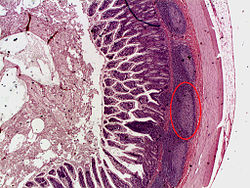Our website is made possible by displaying online advertisements to our visitors.
Please consider supporting us by disabling your ad blocker.
Peyer's patch
| Peyer's patch | |
|---|---|
 Cross section of ileum with a Peyer's patch circled | |
| Details | |
| System | Lymphatic system |
| Identifiers | |
| Latin | noduli lymphoidei aggregati |
| MeSH | D010581 |
| TA98 | A05.6.01.014 A05.7.02.009 |
| TA2 | 2960, 2978 |
| TH | H3.04.03.0.00020 |
| FMA | 15054 |
| Anatomical terminology | |
Peyer's patches (or aggregated lymphoid nodules) are organized lymphoid follicles, named after the 17th-century Swiss anatomist Johann Conrad Peyer.[1] They are an important part of gut associated lymphoid tissue usually found in humans in the lowest portion of the small intestine, mainly in the distal jejunum and the ileum, but also could be detected in the duodenum.[2]
- ^ Peyer, Johann Conrad (1677). Exercitatio Anatomico-Medica de Glandulis Intestinorum, Earumque Usu et Affectionibus [Anatomical-medical essay on the intestinal glands, and their function and diseases] (in Latin). Schaffhausen, Switzerland: Onophrius à Waldkirch.
- Reprinted as: Peyer, Johann Conrad (1681). Exercitatio Anatomico-Medica de Glandulis Intestinorum, Earumque Usu et Affectionibus (in Latin). Amsterdam, Netherlands: Henrik Wetstein.
- Peyer referred to Peyer's patches as plexus or agmina glandularum (clusters of glands). From (Peyer, 1681), p. 7: "Tenui a perfectiorum animalium Intestina accuratius perlustranti, crebra hinc inde, variis intervallis, corpusculorum glandulosorum Agmina sive Plexus se produnt, diversae Magnitudinis atque Figurae." (I knew from careful study of more advanced animals, the intestines bear — often here and there, at various intervals — clusters of glandular small bodies or "plexuses" of diverse size and shape.) From p. 15: "(has Plexus seu agmina Glandularum voco)" (I call them "plexuses" or clusters of glands) He described their appearance. From p. 8: "Horum vero Plexuum facies modo in orbem concinnata; modo in Ovi aut Olivae oblongam, aliamve angulosam ac magis anomalam disposita figuram cernitur." (But the configurations of these "plexuses" are arranged at one time in a circle; at another time, it is seen in an egg [shape] or an oblong olive [shape] or other faceted and more irregularly arranged shape.) Drawings of Peyer's patches appear after pages 22 and 24.
- ^ Zijlstra M, Auchincloss H, Loring JM, Chase CM, Russell PS, Jaenisch R (April 1992). "Skin graft rejection by beta 2-microglobulin-deficient mice". The Journal of Experimental Medicine. 175 (4): 885–93. doi:10.1136/gut.6.3.225. PMC 1552287. PMID 18668776.
Previous Page Next Page


